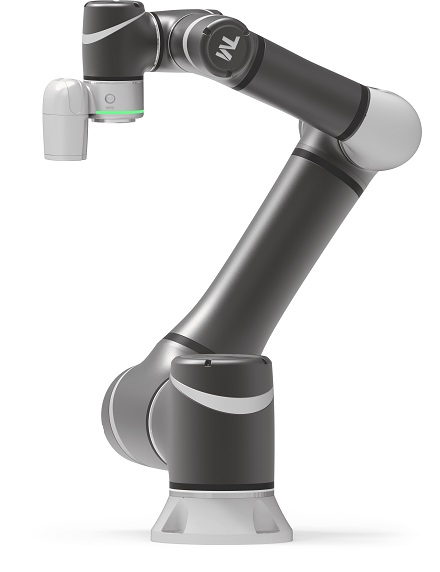Cobot Roundup: Who Makes Them and What Makes Them Special
Cobots have recently been hailed as one of the latest and greatest innovations in production and manufacturing automation. But are collaborative robots living up to their reputation? Control.com investigates the benefits and drawbacks of these versatile industrial machines.
As an engineer, I consider myself a skeptic when it comes to new technology. Not every engineer is skeptical, of course, and like most, I’m happy to try out a new device or system when it becomes available. However, does that mean I am always willing to endorse the marketing claims when a new control product or automation technology is advertised as a revolutionary, ubiquitous solution? Not a chance. Yet many questions remain to be answered.
Collaborative Workplaces
The concept of collaborative robots (cobots) is not new. The core principle is simply a derivative of industrial robots, which have existed since the 1960s. However, this new branch of robotics wasn’t introduced until the mid-2000s, meaning it’s reaching its 20th birthday fairly soon.

Figure 1. Cobots are often used to load CNC machines. Image used courtesy of Adobe Stock
The biggest goal that was intended for this robot derivative was simply to remove the barrier between people and robots. The literal safety cage meant that the entire work envelope of the robot contained wasted floor space, the extra cost of the guarding equipment was prohibitive, and it continues to be difficult to find people with the knowledge of both robots and safety systems to maintain such a work cell.
To optimize the floor footprint meant that the robot must be able to be installed near (or right beside) a human worker, and as you can imagine, this led to some very intense discussions of safety regulations.
What are the Benefits of a Cobot?
We can be fairly confident that modern safety measures are in place to allow the collaborative nature of the work, and each robot has been thoroughly tested. So if we do not need to doubt the safety and the footprint can be reduced, what extra benefits do cobots provide?
Since these robots are allowed to operate near people, we can (with normal, common-sense caution) reach in and manipulate them by hand at any time. This means that, in stark contrast to industrial robots, hand guidance to teach points and paths is the most common programming method. This removes layers of required knowledge to build an effective motion program. A novice cobot user can often design a simple task in less time than a proficient user can build an industrial robot program.
Cost can be more appealing as well since the lack of surrounding infrastructure (safety cages, etc.) eases the material and labor costs for virtually every installation project.
One more advantage is flexibility in application. Most cobots have a smaller reach and payload, as well as a low speed to reduce inertia, so they can be mounted to a cart or table. If you need to pivot and change the manufacturing process, the robot can be moved, secured again, and re-purposed for a new task easily. Some innovators even put them onto a mobile robot to autonomously move through various jobs, although this is far less common.
Are there Disadvantages to Cobots?
Nothing is perfect; and it is here my skepticism returns. Three main design criteria will, in many cases, require a device that outperforms even the best collaborative robots, but this is inevitable due to the original design goals of cobots in the first place.
Limited Cobot Sizes
The payload and reach of even the largest cobot pales in comparison to many major industrial robots. Cobots simply aren’t designed to pick up entire pallets, automobile frames, or other massive assemblies. Even setting standard robot safety aside, if a payload like that were to strike a person even at a low speed, it could be fatal.
Low Operational Speed
If cycle time is critical, and you need pick-and-place operations with mind-blowing speed, the cobot might not be the right fit. Once again, this is not an oversight or accident. Safety regulations prohibit cobots from achieving high speeds, so this limitation must be considered when selecting them for your designs.
For this reason, there are (currently) no collaborative SCARA or delta robots, since they are intended specifically for high-speed operations.
Limited Precision
A cobot is usually less precise than a standard industrial robot, although this is not universal to all models. Typically, a quick programming process is done by hand guidance, which means that inherent error is introduced right at the beginning. Although finite manipulations and adjustments can be done from that point, it is common for accuracy tolerances to be widened to allow for slight process variations, such as metal blanks that are slightly varying in size.
Once again, not an oversight, but a design factor in consideration of the intended tasks for which a cobot was built.
Are Cobots Ideal for Every Application?
In summary, are cobots a perfect fit for everyone? No.
But they can be a much more affordable point of entry into robotics for many companies and applications, so if you find yourself in a place to investigate this new addition, here is a selection of many of the companies and product lines offering collaborative robots. They are presented in this list in no pre-determined order, and Control.com does not offer comparative reviews of cobots.
Yaskawa Motoman
HC Series

Universal Robots
UR Series

Kassow
KR Series

FANUC
CR/CRX Series

Kawasaki
CL and duAro Series

ABB
SWIFTI/GoFa/YuMi

Techman
TM /S Series

Doosan
H/M/A/E Series

Dobot
CRA Series

Mitsubishi
Melfa Assista

KUKA
Lbr iisy

DENSO
Cobotta

Beckhoff
ATRO

Did We Miss Any?
If you are interested in your cobot lineup being added to this list, please reach out to [email protected] we would love to provide a wide assortment of options for engineers to select and choose the right products for individual applications.





